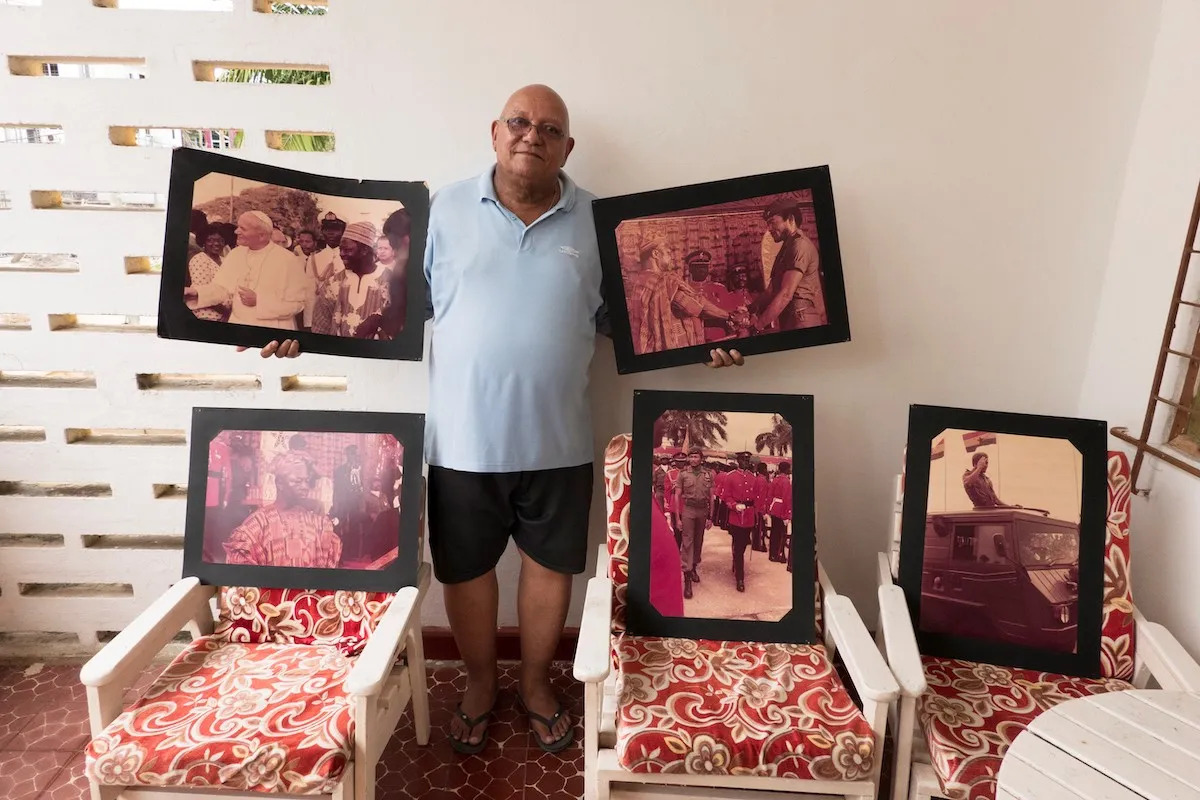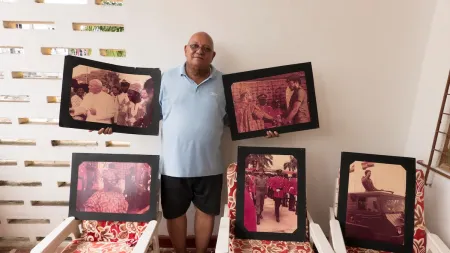
When Queen Elizabeth II arrived in Ghana in 1999 on an official visit, the British High Commission called Gerald Annan-Forson about photographing the monarch in a private session. Years beforehand, Annan-Forson had developed a habit of standing before Buckingham Palace with the dream of taking images of the queen or the royal family someday. The Commission’s request came as a surprise.
“I said, ‘Well, wait a minute. She’s coming with all these pressmen. Why me?’” he recounted, speaking to ARTnews from Accra, the capital of the West African country, in a recent interview. “They said, ‘Well, we have been watching you. We’ve selected you from within Ghana.’”
That they selected him at all speaks to the “important role” he played in capturing Ghana, particularly Accra, as the center of various global artistic and political changes, said Jesse Weaver Shipley, a professor of African and African American studies at Dartmouth College.
Shipley and Annan-Forson first met in 2017 through an introduction by the late former president of Ghana, Flight Lieutenant Jerry John Rawlings, who had spoken glowingly about the artist’s images taken in Ghana in the 1970s and 80s. After seeing Annan-Forson’s “incredible collection of images,” Shipley wondered why the artist and his work hadn’t received the deserved acclaim.
Now, Annan-Forson’s first retrospective has arrived Stateside following a run at the Sharjah Art Foundation in collaboration with the Africa Institute in 2022. Curated by Shipley, the show features images that testify to the social and political transformations that shaped Ghana during the late 20th century. Opened earlier this month, the show is now on view at the Howard University Museum in Washington, D.C., where it is being presented by the school’s Moorland-Spingarn Research Center.
“His brilliance as a photographer is to find the subtle, intimate moments in the midst of daily life,” said Shipley. “His work crosses genres. It tells a story about how images don’t just speak in a singular way, but images are always multiple. They’re always telling various stories at once.”
One of the show’s highlights is a 1980 image of a group of people celebrating Ramadan with two people riding horses in Central Accra, near a place called Glamour, which no longer exists as it did when the photo was taken. It informs Annan-Forson’s idea to capture life as it happens, knowing that “if you don’t document them, they are gone. And once they are gone, you probably can’t get it again,” he said.
Another exhibition highlight is an image from September 24, 1979, showing Flt. Lt. Jerry John Rawlings, having relinquished his post, looking on while Hilla Limann, the recently elected Democratic president, inaugurates Ghana’s Third Republic. On December 31, 1981, Rawlings overthrew Limann, coming into power for the second time as a military leader.

“[Annan-Forson captured] these offbeat, unusual moments that were prescient,” Shipley said. “[That were] sort of privy to the way that history was going to go, and he didn’t even know it. That’s what a great artist can do.”
Annan-Forson spoke about those images more humbly, saying, “I tried to capture moments, but not the regular thing that everybody does, like a handshake.”
As a former schoolmate at Achimota College, a friend, and a freelance professional photographer, Annan-Forson had access to Rawlings and his family during his tenure as a military leader and later as a democratically elected president. Annan-Forson was invited to family events, including dinner, and photographed the family at their house. But no matter where he was, Annan-Forson recalled, the soldiers around Rawlings insisted he is addressed as “Mr. Chairman.”
“When he was a military man, there was a fear of not getting it right because there is no way you are going to go back and tell the Chairman of the AFRC [Armed Forces Revolutionary Council], ‘Hey, this was a rehearsal, can we do it again?’ You have to make sure that you get it right,” recalled Annan-Forson. “But it was a lot more relaxed with him being a civilian.”
Some people called Annan-Forson “Jerry,” an abbreviated version of his first name, Gerald, and a name that Rawlings himself went by. As a result, Annan-Forson recalled that during assignments he was sometimes presented as a “decoy, so to speak,” of Rawlings at public events. Sometimes, this was funny to Annan-Forson. Other times, he found it scary. He was just there as a photographer, after all.
Those weren’t the only scary moments: during the rule of military leader General Ignatius Kutu Acheampong, Annan-Forson was picked up and interrogated by the military police, who thought he was using a Bazooka because of the length of his lens. Annan-Forson learned that the government had been surveilling him in the late 1970s because he was assumed to be a CIA agent who had learned to speak Ghanaian languages. He told himself there was no guarantee of returning home whenever he went out to photograph during the tenure of military governments.

Annan-Forson was born in London in 1947 to a Ghanaian father and a British mother from Ireland. In 1976, he became a freelance professional photographer in London, relocating to Accra later that year. In Ghana, he noticed a lot of negative coverage about the country and its capital, and was determined to offer more positive images of them.
Unlike other photographers of his time, who were using camera boxes, Annan-Forson utilized 35mm film, carrying more than one camera at a time. This meant he could take a lot more shots compared to his colleagues.
He wanted to capture Ghana, especially its culture, its people, how market women dressed, and festivals held there. Having shot the local scene, he moved on to working on commission for international magazines, and then scored a Ministry of Information press card in 1977 that granted him access to areas that required press accreditation. The pictures he shot were seen abroad and in Ghana—some were even exhibited at the Ghana Arts Council in Accra in 1980.
In 1987, he became a founding member of the Ghana Union of Professional Photographers, which supports rising young photographers and builds networks and resources to raise the level of professional photography in the country. He has since retired from freelance photography and teaching, and now works from a studio at home in Accra.
Shipley, who is an artist and curator in addition to being an academic, has made a short documentary about Annan-Forson that is featured in “Routes of Rebellion” exhibition currently on view at the Nuku Studio Center for Photographic Research and Practice and Red Clay Studio, both in Tamale. Titled Burnt Images, the documentary explores the life and work of Annan-Forson and taking up photography as a way to grapple with racial prejudice. It also looks at some of the work in the US presentation.
Shipley’s practice as an artist, he says, including bringing Annan-Forson’s work to Sharjah, the United States, and his Tamale show, is in “some ways about creating dialogues [and] new forms of communication.”

Annan-Forson’s show at Howard is a far cry from when he started, at a time when it was hard to get his works printed. He said he never “thought about getting credit or, for that matter, getting cash” for his work, but he is happy where things have landed.
He continued that he hoped that his photographs will be “used for educational purposes or research.” With the Howard show, this is no longer a dream.
“I think there will be a deep interest in the images in this exhibit,” said Benjamin Talton, a history professor at Howard and director of the Moorland-Spingarn Research Center. “The students will learn a great deal from it.”
At NFT.NYC, Web3 Types Focus on Merchandising and the Art World Heads Elsewhere
Colorado Gallery Sells Mayan Artifacts Despite Demands To Stop From Mexican Officials

Putter’s Paradise: The $39 Million Pebble Beach Estate Wants to Help You Sharpen Your Short Game

The Worst Dressed Stars in CMT Awards History

Best fitness apps for Apple Watch and iPhone

Caitlin Clark Effect Pushes WNBA Champs to Larger Vegas Venue


